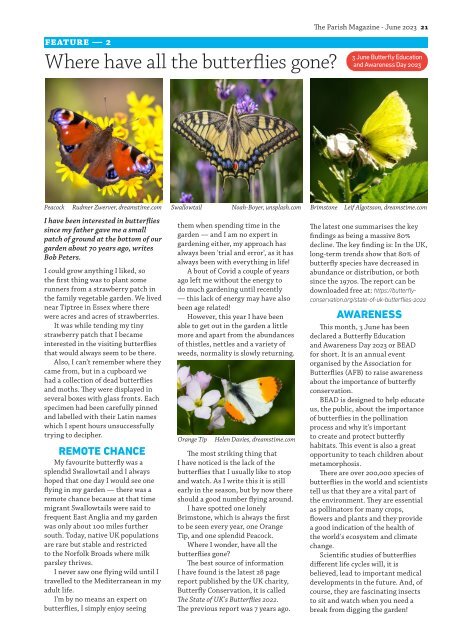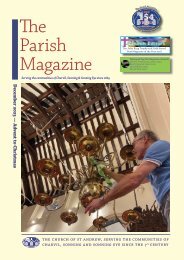The Parish Magazine June 2023
Serving the communities of Charvil, Sonning, and Sonning Eye since 1869
Serving the communities of Charvil, Sonning, and Sonning Eye since 1869
You also want an ePaper? Increase the reach of your titles
YUMPU automatically turns print PDFs into web optimized ePapers that Google loves.
feature — 2<br />
Where have all the butterflies gone?<br />
<strong>The</strong> <strong>Parish</strong> <strong>Magazine</strong> - <strong>June</strong> <strong>2023</strong> 21<br />
3 <strong>June</strong> Butterfly Education<br />
and Awareness Day <strong>2023</strong><br />
Peacock Rudmer Zwerver, dreamstime.com Swallowtail Noah-Boyer, unsplash.com<br />
I have been interested in butterflies<br />
since my father gave me a small<br />
patch of ground at the bottom of our<br />
garden about 70 years ago, writes<br />
Bob Peters.<br />
I could grow anything I liked, so<br />
the first thing was to plant some<br />
runners from a strawberry patch in<br />
the family vegetable garden. We lived<br />
near Tiptree in Essex where there<br />
were acres and acres of strawberries.<br />
It was while tending my tiny<br />
strawberry patch that I became<br />
interested in the visiting butterflies<br />
that would always seem to be there.<br />
Also, I can't remember where they<br />
came from, but in a cupboard we<br />
had a collection of dead butterflies<br />
and moths. <strong>The</strong>y were displayed in<br />
several boxes with glass fronts. Each<br />
specimen had been carefully pinned<br />
and labelled with their Latin names<br />
which I spent hours unsuccessfully<br />
trying to decipher.<br />
REMOTE CHANCE<br />
My favourite butterfly was a<br />
splendid Swallowtail and I always<br />
hoped that one day I would see one<br />
flying in my garden — there was a<br />
remote chance because at that time<br />
migrant Swallowtails were said to<br />
frequent East Anglia and my garden<br />
was only about 100 miles further<br />
south. Today, native UK populations<br />
are rare but stable and restricted<br />
to the Norfolk Broads where milk<br />
parsley thrives.<br />
I never saw one flying wild until I<br />
travelled to the Mediterranean in my<br />
adult life.<br />
I'm by no means an expert on<br />
butterflies, I simply enjoy seeing<br />
them when spending time in the<br />
garden — and I am no expert in<br />
gardening either, my approach has<br />
always been 'trial and error', as it has<br />
always been with everything in life!<br />
A bout of Covid a couple of years<br />
ago left me without the energy to<br />
do much gardening until recently<br />
— this lack of energy may have also<br />
been age related!<br />
However, this year I have been<br />
able to get out in the garden a little<br />
more and apart from the abundances<br />
of thistles, nettles and a variety of<br />
weeds, normality is slowly returning.<br />
Orange Tip<br />
Helen Davies, dreamstime.com<br />
<strong>The</strong> most striking thing that<br />
I have noticed is the lack of the<br />
butterflies that I usually like to stop<br />
and watch. As I write this it is still<br />
early in the season, but by now there<br />
should a good number flying around.<br />
I have spotted one lonely<br />
Brimstone, which is always the first<br />
to be seen every year, one Orange<br />
Tip, and one splendid Peacock.<br />
Where I wonder, have all the<br />
butterflies gone?<br />
<strong>The</strong> best source of information<br />
I have found is the latest 28 page<br />
report published by the UK charity,<br />
Butterfly Conservation, it is called<br />
<strong>The</strong> State of UK's Butterflies 2022.<br />
<strong>The</strong> previous report was 7 years ago.<br />
Brimstone<br />
Leif Algotsson, dreamstime.com<br />
<strong>The</strong> latest one summarises the key<br />
findings as being a massive 80%<br />
decline. <strong>The</strong> key finding is: In the UK,<br />
long-term trends show that 80% of<br />
butterfly species have decreased in<br />
abundance or distribution, or both<br />
since the 1970s. <strong>The</strong> report can be<br />
downloaded free at: https://butterflyconservation.org/state-of-uk-butterflies-2022<br />
AWARENESS<br />
This month, 3 <strong>June</strong> has been<br />
declared a Butterfly Education<br />
and Awareness Day <strong>2023</strong> or BEAD<br />
for short. It is an annual event<br />
organised by the Association for<br />
Butterflies (AFB) to raise awareness<br />
about the importance of butterfly<br />
conservation.<br />
BEAD is designed to help educate<br />
us, the public, about the importance<br />
of butterflies in the pollination<br />
process and why it's important<br />
to create and protect butterfly<br />
habitats. This event is also a great<br />
opportunity to teach children about<br />
metamorphosis.<br />
<strong>The</strong>re are over 200,000 species of<br />
butterflies in the world and scientists<br />
tell us that they are a vital part of<br />
the environment. <strong>The</strong>y are essential<br />
as pollinators for many crops,<br />
flowers and plants and they provide<br />
a good indication of the health of<br />
the world's ecosystem and climate<br />
change.<br />
Scientific studies of butterflies<br />
different life cycles will, it is<br />
believed, lead to important medical<br />
developments in the future. And, of<br />
course, they are fascinating insects<br />
to sit and watch when you need a<br />
break from digging the garden!

















